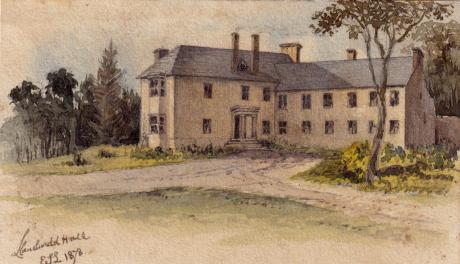inscribed signed with monogram and dated " Llanelwedd E.T.L. 1878"
Llanelwedd Hall was a substantial timber-framed house, possibly of two builds. When visited during reconstruction in 1976 it was noted as a large double-pile house, apparently built of stone and brick, partly burnt by a fire in 1955 with the remaining structure consolidated. The rebuilding work revealed the remains of early timber-framed units later encased by a variety of materials. The earlier structure, on the west, dates from about 1550 and is set on a solid stone plinth 0.6m high. The other timber-framed unit, to the east, sits on a low plinth and appears to date from the seventeenth century; it was possibly enlarged to the north by the addition of two parallel wings. Later alterations have completely obscured the original floor plan.
Llanelwedd Hall was surrounded by gardens (nprn 86239); the whole complex is now a part of the Royal Welsh Showground (nprn 268049), the hall having been rebuilt as its headquarters and main offices.
LLANELWETH (LLAN-ELWEDD), a parish, in the union of Builth, hundred of Colwyn, county of Radnor, South Wales, nearly 1 mile (N. E.) from Builth; containing 197 inhabitants. This parish is pleasantly situated on the river Wye, by which it is separated on the south and south-west from the parish of Builth, in the county of Brecknock; and is intersected by the turnpike-road from that place to Newtown, in Montgomeryshire, from which, soon after it enters this parish, branches a road up the eastern bank of the Wye to Rhaiadr, and further on, near the church, branches another road to New Radnor, Kington, Presteign, and Leominster. The surface is generally undulated, with some abrupt eminences of considerable height, and the lands, with the exception of some elevated commons and a small rocky district, are inclosed and in an excellent state of cultivation. The surrounding scenery is pleasingly varied; and the views from the higher grounds, and especially from the rocks beyond Wellfield, are extensive and extremely rich: in the neighbourhood are a few gentlemen’s seats. Llanelweth Hall, the ancient residence of the Gwynnes, of Garth, in the county of Brecknock, (of which family was Marmaduke Gwynne, a judge on the North Wales circuit, who died in 1712,) has been deserted by its proprietor, and is now in the occupation of a tenant. Wellfield House, erected in 1787, by David Thomas, Esq., of London, descend ed from a branch of the family of Thomas, of Llwyn Madoc, in Brecknockshire, is a spacious and hand some mansion, with a portico of the Tuscan order, finely situated on a lofty eminence, and embosomed in flourishing plantations, forming a prominent object from every point of view, and strikingly contrasted with the rugged barrenness of some of the adjacent heights: the grounds are pleasingly ornamented with shrubberies and walks, and command a fine prospect, including the rivers Wye and Irvon winding through their respective vales, with the town of Builth and the adjacent country. From the summit of an eminence on this estate is one of the most extensive and magnificent panoramic views in any part of the principality; comprehending a circle of more than twelve miles in the radius, entirely in closed with lofty hills, and embracing a vast number of interesting objects, and a rich variety of beautiful and picturesque scenery: to the east are the Black Mountains, of dreary and rugged appearance, with the acclivities of others of more softened aspect; and to the west are the mountains of Tregarn and Garn Wen, the former said to be the highest ridge, next to the Beacons, in this part of South Wales, and the latter remarkable for its conical form, and the cairn that crowns its summit. About a mile to the north of Wellfield is Penkerrig House, which has been recently enlarged and partly rebuilt, and embellished with a new front in the Elizabethan style; it is pleasingly ornamented with a rich plantation of ever-greens, and is sheltered in the rear by a hill of considerable elevation, with stately timber: in the grounds, which are laid out with great taste, is a fine sheet of water, covering about six acres; and the view from the house, though not extensive, is picturesque.


